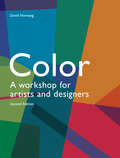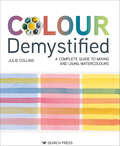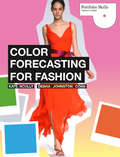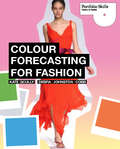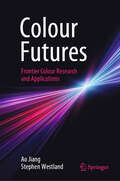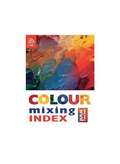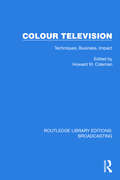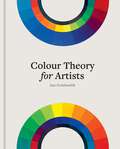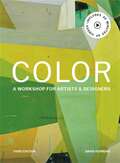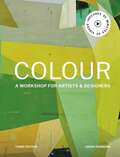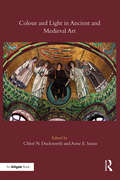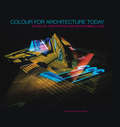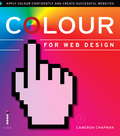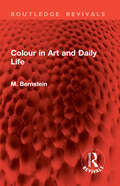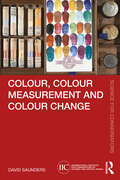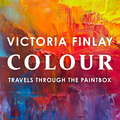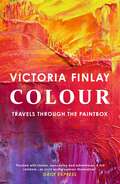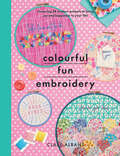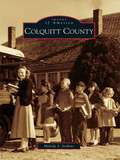- Table View
- List View
Colour 2nd edition: A Workshop Approach
by David HornungTaking a practical approach to color, Color: A workshop for artists and designers is an invaluable resource for art students and professionals alike. With its sequence of specially designed assignments and in-depth discussions, it effectively bridges the gap between color theory and practice to inspire confidence and understanding in anyone who works with color.This second edition has been carefully reviewed and revised throughout. Presented in a new larger format, it includes much-enhanced sections on key color principles such as color perception, visual structure, materials and techniques, psychological experience of color, and color composition in digital formats.Generously illustrated—including all-new, contemporary examples—this book provides a unique set of tools that makes the complex theory of color accessible and practical.
Colour Demystified: A Complete Guide to Mixing and Using Watercolours
by Julie CollinsColour Demystified will banish the all-too-common confusion over the watercolour palette and give painters the confidence to experiment with colour mixing. This book demystifies colour, and helps artists understand how colour works in a highly visual way through the use of colour charts accompanied by examples, practical exercises, and analyses of watercolour paintings. Numerous artworks by a variety of contemporary artists are featured in the book, covering a broad range of subjects and palettes. Topics such as granulation, iridescence, staining strength, and transparent and opaque colours are explained clearly and simply, and there is practical guidance on colour relationships, using colour to create space, and how to be more creative with colour. Armed with a clearer understanding of colour and how it looks and behaves on paper, artists will be encouraged to be more bold and creative in their use of colour in their art.
Colour Forecasting for Fashion
by Kate Scully Debra Johnston Cob Debra Johnston CobbColor is a powerful selling tool. It is the first thing to catch the consumer's eye in the shop window. Get the color choice wrong and an entire range can stay on the racks. So, how do colors arrive on the runway or the sales floor and why do different companies all seem to choose similar colors each season? The answer lies in the work of the huge color forecasting industry. Color Forecasting for Fashion breaks down the forecasting process—from how to put together a color palette to color theory and the way that colors behave—and helps you to build the combination of research and intuitive skills that a successful designer or forecaster needs.
Colour Forecasting for Fashion
by Kate ScullyColour is a powerful selling tool. It is the first thing to catch the consumer's eye in the shop window. Get the colour choice wrong and an entire range can stay on the racks. So, how do colours arrive on the catwalk or the sales floor – and why do different companies all seem to choose similar colours each season? The answer lies in the work of the huge colour forecasting industry.With case studies that show the industry at work, this book breaks down the forecasting process – from how to put together a colour palette to colour theory and the way that colours behave – and helps you to build the combination of research and intuitive skills that a successful designer or forecaster needs.
Colour Forecasting for Fashion (Portfolio Skills)
by Kate Scully Debra Johnston Cob Debra Johnston CobbColour is a powerful selling tool. It is the first thing to catch the consumer's eye in the shop window. Get the colour choice wrong and an entire range can stay on the racks. So, how do colours arrive on the catwalk or the sales floor – and why do different companies all seem to choose similar colours each season? The answer lies in the work of the huge colour forecasting industry.With case studies that show the industry at work, this book breaks down the forecasting process – from how to put together a colour palette to colour theory and the way that colours behave – and helps you to build the combination of research and intuitive skills that a successful designer or forecaster needs.
Colour Futures: Frontier Colour Research and Applications (Vision, Illusion and Perception #5)
by Stephen Westland Ao JiangThis book delves into the nuanced interplay of colour in human perception and its applications across diverse fields, highlighting the transformative impact on art, design, digital media, and technology. The book introduces an innovative approach by integrating scientific research with practical applications, making it a pivotal resource for designers, psychologists, and technologists. Its scope ranges from foundational aspects of colour vision to futuristic applications in virtual reality and artificial intelligence, offering fresh insights and forecasting emerging trends. This comprehensive exploration is essential for anyone interested in the strategic use of colour to enhance user experience and cultural expressions.
Colour Mixing Index
by Julie CollinsThis one-stop color-mixing reference for artists of all abilities covers mixes for the five key media: Watercolor Oils Gouache Acrylics Ink An indispensable visual directory of over 8,000 appropriate mixes for practicing artists, it includes an essential introduction to color and color mixing, as well as information on the best materials to use. Find answers to all your color mixing problems in this comprehensive, easy-to-use, pocket-sized volume.
Colour Second Edition: A workshop for artists, designers
by David HornungTaking a practical approach to color, Color: A workshop for artists and designers is an invaluable resource for art students and professionals alike. With its sequence of specially designed assignments and in-depth discussions, it effectively bridges the gap between color theory and practice to inspire confidence and understanding in anyone who works with color.This second edition has been carefully reviewed and revised throughout. Presented in a new larger format, it includes much-enhanced sections on key color principles such as color perception, visual structure, materials and techniques, psychological experience of color, and color composition in digital formats.Generously illustrated—including all-new, contemporary examples—this book provides a unique set of tools that makes the complex theory of color accessible and practical.
Colour Television: Techniques, Business, Impact (Routledge Library Editions: Broadcasting #17)
by H.W. ColemanColour Television (1968) examines the rapid growth of colour television in the 1960s as technological advances enabled programmes to be effectively transmitted in colour for the first time. It looks at the technologies involved, the differences in programme-making that colour required, the audience response, and the changes in advertising and network systems that colour broadcasting brought about.
Colour Theory for Artists: Everything you need to know about working with colour
by Ian GoldsmithThe essential guide to colour theory and mixing for artists. Full of beautiful, intricate handpainted colour wheels and practical advice on using and mixing colour, this book is a must-have for any artist working with pigment and paint. Starting from the basics of colour and working up to the complexities of tonality, harmony, opacity and pigment, artist Ian Goldsmith explores and explains all the key elements of colour and what it can do. A comprehensive paint index at the back of the book provides an indispensable reference guide for choosing and purchasing materials that no practising artist should be without.Including:- Understanding the colour wheel - Primaries, secondaries and tertiaries- Colour temperature- Hue, value and saturation - Opacity and transparency- Materials and pigments
Colour Theory for Artists: Everything you need to know about working with colour
by Ian GoldsmithThe essential guide to colour theory and mixing for artists. Full of beautiful, intricate handpainted colour wheels and practical advice on using and mixing colour, this book is a must-have for any artist working with pigment and paint. Starting from the basics of colour and working up to the complexities of tonality, harmony, opacity and pigment, artist Ian Goldsmith explores and explains all the key elements of colour and what it can do. A comprehensive paint index at the back of the book provides an indispensable reference guide for choosing and purchasing materials that no practising artist should be without.Including:- Understanding the colour wheel - Primaries, secondaries and tertiaries- Colour temperature- Hue, value and saturation - Opacity and transparency- Materials and pigments
Colour Third Edition: A workshop for artists, designers
by David HornungA chronicle of the key ideas that have shaped the commercials we see everyday, 100 Ideas That Changed Advertising offers a fascinating insight into an ever-changing and fast-moving business.Arranged broadly chronologically, the book looks at the overnight revolutions, the flashes of inspiration, and the long-term evolutions that have shaped the industry. Author Simon Veksner guides us through the key ideas behind these changes, from the development of the first advertising formats and the history of branding, to the creative revolutions of the 1960s and the digital age. Looking forward, the book considers the most recent thinking in reaching new audiences, including the rise of neuromarketing and the latest behavioral economics.Illustrated with hundreds of examples of adverts and explaining their power to grab our attention, the book is an absorbing guide to a turbulent industry.
Colour Third Edition: A workshop for artists, designers
by David HornungA chronicle of the key ideas that have shaped the commercials we see everyday, 100 Ideas That Changed Advertising offers a fascinating insight into an ever-changing and fast-moving business.Arranged broadly chronologically, the book looks at the overnight revolutions, the flashes of inspiration, and the long-term evolutions that have shaped the industry. Author Simon Veksner guides us through the key ideas behind these changes, from the development of the first advertising formats and the history of branding, to the creative revolutions of the 1960s and the digital age. Looking forward, the book considers the most recent thinking in reaching new audiences, including the rise of neuromarketing and the latest behavioral economics.Illustrated with hundreds of examples of adverts and explaining their power to grab our attention, the book is an absorbing guide to a turbulent industry.
Colour Third Edition: A workshop for artists, designers
by David HornungTaking a practical approach to colour, Colour: A workshop for artists and designers is an invaluable resource for art students and professionals alike. With its sequence of specially designed assignments and in-depth discussions, it effectively bridges the gap between colour theory and practice to inspire confidence and understanding in anyone working with colour. This third edition is updated with more contemporary examples drawn not just from painting, but from textiles, graphic design, illustration and animation. An expanded discussion of digital techniques, new assignments and a refreshed design have all been brought together to create a highly readable and relevant text.
Colour Third Edition: A workshop for artists, designers
by David HornungTaking a practical approach to colour, Colour: A workshop for artists and designers is an invaluable resource for art students and professionals alike. With its sequence of specially designed assignments and in-depth discussions, it effectively bridges the gap between colour theory and practice to inspire confidence and understanding in anyone working with colour. This third edition is updated with more contemporary examples drawn not just from painting, but from textiles, graphic design, illustration and animation. An expanded discussion of digital techniques, new assignments and a refreshed design have all been brought together to create a highly readable and relevant text.
Colour and Light in Ancient and Medieval Art
by Chloë N. Duckworth Anne E. SassinThe myriad ways in which colour and light have been adapted and applied in the art, architecture, and material culture of past societies is the focus of this interdisciplinary volume. Light and colour’s iconographic, economic, and socio-cultural implications are considered by established and emerging scholars including art historians, archaeologists, and conservators, who address the variety of human experience of these sensory phenomena. In today’s world it is the norm for humans to be surrounded by strong, artificial colours, and even to see colour as perhaps an inessential or surface property of the objects around us. Similarly, electric lighting has provided the power and ability to illuminate and manipulate environments in increasingly unprecedented ways. In the context of such a saturated experience, it becomes difficult to identify what is universal, and what is culturally specific about the human experience of light and colour. Failing to do so, however, hinders the capacity to approach how they were experienced by people of centuries past. By means of case studies spanning a broad historical and geographical context and covering such diverse themes as architecture, cave art, the invention of metallurgy, and medieval manuscript illumination, the contributors to this volume provide an up-to-date discussion of these themes from a uniquely interdisciplinary perspective. The papers range in scope from the meaning of colour in European prehistoric art to the technical art of the glazed tiles of the Shah mosque in Isfahan. Their aim is to explore a multifarious range of evidence and to evaluate and illuminate what is a truly enigmatic topic in the history of art and visual culture.
Colour for Architecture Today
by Tom Porter Terry Farrell Byron MikellidesWhat role does colour play in our built environment? How are our attitudes to colour changing? What potential do new technologies bring for the use of colour and light in architecture? Combining real examples from practice with colour theory, this book will help you to fully understand the role and impact of colour in our urban spaces. Contributions from leading architects Will Alsop, Legorreta and Legorreta, John Outram, Sauerbruch Hutton and Neuterlings Riedijk accompany those from artists Alain Bony and Yann Kersalé, and from colour researchers such as Kristina Enberg and Anders Hård, who developed the Natural Colour System. Topics include: how and why we see colour methodologies in the documentation of traditional colours the development of new urban palettes recent colour psychology research the effect of light levels on human behaviour dramatic colour effects achievable with light guidelines for future deployment of colour in the built environment. This is a sequel to the immensely influential Colour for Architecture, published in 1976. Much has changed in 30 years; new cutting edge technologies and materials have emerged allowing architects to experiment with colour and light in an energy efficient and sustainable way, paving the way for a more colourful and exciting built environment.
Colour for Web Design: Apply Colour Confidently and Create Successful Websites
by Cameron ChapmanColour is one of the most powerful tools at a designer's disposal, yet few truly understand how much it can do for them, and the immediate difference it will make to the popularity and success of their website.This is the complete guide to creating a unique, practical and appropriate colour palette for any web design project. Building on the basics, starting with essential - often misunderstood - terminology and an understanding of traditional colour palettes, the book then moves on to practical, real-world examples of sites with fantastic colour schemes.A one-stop shop for a complete knowledge of digital colour, this book will give the designer the confidence to create their own palettes and apply colour successfully to their designs.
Colour in Art and Daily Life (Routledge Revivals)
by M. BernsteinFirst published in 1928, Colour in Art and Daily Life presents a series of fascinating essays analysing and expounding the beauty of colours, their relationship to one another and to line, surface and form. For the layman, as for the art student, there is set forth in this book the knowledge that will not only enrich her understanding of the great masters of painting but will also educate her taste in the appreciation of colour in everyday life.
Colour, Colour Measurement and Colour Change (Science for Conservators)
by David SaundersColour, Colour Measurement and Colour Change, the first new book in the expanded Science for Conservators series, explains the science of colour, colour measurement and colour change for conservators in a clear and comprehensible way, elucidating the topic for those with no scientific background.The book explains how and why we see colours and how colour and colour change can be measured, as well as clarifying why these would be done in a conservation context. It then examines the ways in which colour can change – such as darkening, yellowing, fading, blanching and patination – illustrating these in different types of cultural heritage materials, including metals, varnishes, plastics, textiles and paints. The final chapter explores how colour change can be reduced in different types of storage and display settings, and, in particular, what can be done to protect against damage by light, damp and pollutants.This book is an invaluable introduction to all aspects of the science of colour in conservation. It is suitable for students in undergraduate and postgraduate conservation programmes, as well as being a useful reference guide for practising conservators.
Colour: Travels Through the Paintbox
by Victoria Finlay'A rare and wonderful book... I could not be more enthusiastic.' Simon Winchester'A treasure trove of human history and obsession...the breadth of research and insight is dazzling.' Glasgow Herald'A highly companionable guide, adventurous and romantic' Independent on SundayOn a journey that takes her from Afghanistan, to the Australian outback, to ancient caves in China, and the saffron harvest in Spain, Victoria Finlay gives an extraordinary and compelling account of the history of colour. On a journey that takes her from Afghanistan, to the Australian outback, to ancient caves in China, and the saffron harvest in Spain, Victoria Finlay gives an extraordinary and compelling account of the history of colour.Colour unlocks the history of the colours of the rainbow, and reveals how paints came to be invented, discovered, traded and used. This remarkable and beautifully written book, part travelogue part narrative history, remembers a time when red paint was really the colour of blood, when orange was the poison pigment, blue as expensive as gold, and yellow made from the urine of cows force-fed with mangoes. It looks at how green was carried by yaks along the silk road, and how an entire nation was founded on the colour purple.Exciting, richly informative, and always surprising, Colour lifts the lid on the historical palette and unearths an astonishing wealth of stories about the quest for colours, and our efforts to understand them.(P)2022 Hodder & Stoughton Limited
Colour: Travels Through the Paintbox
by Victoria Finlay'A rare and wonderful book... I could not be more enthusiastic.' Simon Winchester'A treasure trove of human history and obsession...the breadth of research and insight is dazzling.' Glasgow HeraldColour unlocks the history of the colours of the rainbow, and reveals how paints came to be invented, discovered, traded and used. This remarkable and beautifully written book, part travelogue part narrative history, remembers a time when red paint was really the colour of blood, when orange was the poison pigment, blue as expensive as gold, and yellow made from the urine of cows force-fed with mangoes. It looks at how green was carried by yaks along the silk road, and how an entire nation was founded on the colour purple.'A highly companionable guide, adventurous and romantic' Independent on SundayExciting, richly informative, and always surprising, Colour lifts the lid on the historical palette and unearths an astonishing wealth of stories about the quest for colours, and our efforts to understand them.
Colourful Fun Embroidery: Featuring 24 modern projects to bring joy and happiness to your life! (Crafts Ser.)
by Clare AlbansBe creative, de-stress and brighten up your world with these twenty-four embroidery projects for crafters of all skill levels. With projects ranging from things you could complete in an afternoon to others that you can take your time over, enjoy every step of the making process as you focus on feeling good through being creative. The finished makes will bring colour and joy to your home, workspace and wardrobe. The projects in this book allow you to craft your creative time by selecting makes according to timescale. Choose one of the &“crafternoon makes&” if you want that sense of joy at finishing something, a &“medium makes&” project for the days where you have a little more time for crafting, or for something to really take your time over you could stitch one of the longer &“pick me up&” projects. Each project includes step-by-step instructions, beautiful photos and inspirational ideas for how to make each project your own. So take time to be creative with this colourful, feel-good craft book!Praise for Colourful Fun Embroidery&“With clear, precise instructions, Celia's book on creative embroidery is just what is needed!&” —Books Monthly (UK)&“Fulfilling a tall order for embroidery that generates glee, UK crafter-author Albans tries her hardest to infuse some lightness of embroidery into daily life with bright colors, perky sayings, and displayable projects. Her two dozen projects range from brooches and necklaces to banners and patchwork, each indicating the time needed to finish. Every design supports a beginning needleworker. . . . And though some projects have a very British feel (such as buntings to top a cake), many will appeal to U.S. tastes. A stitch in time might provoke some smiles. Other appendixes include embroidery materials, embroidery stitch guide, template information, and craft suppliers (primarily in the UK).&” —Booklist
Colquitt County
by Melody S. JenkinsLocated in an area known as the "Pine Barrens" because the branches of the dense, virgin pine trees interlaced so tightly that they almost blocked the sun's rays and prevented the growth of ground vegetation, Colquitt County was formed from Thomas and Lowndes Counties in 1856. The county was named for Walter T. Colquitt, a Methodist minister, Georgia's most successful criminal lawyer, and a state senator. The 1860 Federal Census listed 1,360 residents in the county's 547.5 square miles. Set up as a buffer zone between the Seminole Indians of Florida and the Lower Creeks of Georgia, the area was considered by some members of the Georgia Assembly as "practically useless" and not worthy of state expenditures for road construction. From this inauspicious beginning, Colquitt County has grown to be a leader in agricultural, industrial, military, municipal, educational, historic, and artistic endeavors. Colquitt County continues to be a leader in all aspects of community life, from the early days of logging, naval stores, farming, and livestock production, to modern advances in education, manufacturing, agriculture, and the arts.
Colt Single Action: From Patersons to Peacemakers
by Dennis AdlerThis book spans the entire history of Sam Colt's developments in handguns. It follows the first Paterson revolvers through the legendary 1860 Army and the evolution of cap and ball revolvers into the cartridge models carried during the Western Expansion of the 1870s. Author and photographer Dennis Adler takes you on a historical journey through time with striking studio photography of the world's greatest Colt revolvers, factory archival images and original patent drawings, and tales of the soldiers, lawmen, and lawbreakers who made Colt revolvers part of American history.
